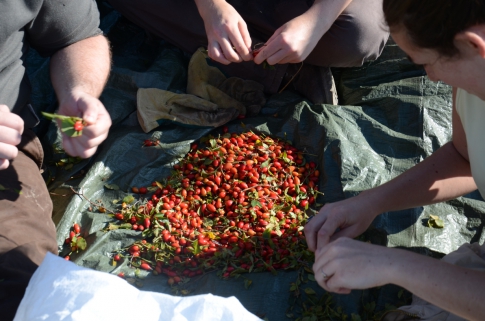News
2015-09-15
Fruit harvests in Haute Durance: for a plantation on site in 2017 ! (F)
The LIFE Elia-RTE project works on seven sites in France in close collaboration with RTE. The site in Haute Durance will be partly planted in 2017 to create forest edges. To ensure the local origin of the plants, the team is ready to travel and work... starting with the harvest. Seeds of local origins will be extracted from harvested fruits and put in a local nursery, in association with the Hainaut Provincial High School - Condorcet in Belgium.

Fig.1.- Sorting rosehips from dog-roses
Initial situation
The restoration and creation of forest edges based on the selection of woody species of reasonable dimensions play an important ecological role and ensures the safety of high-voltage lines. The choice of these species is based on the regions where plantations are to be carried out. To ensure local origin, the best option is to collect fruits close to the sites, and to extract seeds in order to sow them directly. This approach ensures a full traceability from harvest fruit to plantation on site.
Collaborations
Harvest sites have been spotted with the support of existing partners structures knowing the species distribution in the area concerned. The Conservatory for Botanical National Alpine and the Office National des Forêts were closely involved in setting the harvest sites, offering various areas likely to be occupied by the targeted species. The presence of a specie does not necessarily mean that it will bear fruits, prospecting the sites will help choosing harvesting areas. To ensure an efficient harvest, a team of 6 people was created, a combination of LIFE team members and students in "Forest and Nature" of HEPH-C.
Harvest methods
Surveys have uncovered a dozen of species on which harvesting could be done between Embrun and Gap.

Fig.3.- Sorting hawthorn fruits after shaking the tree
Harvesting techniques vary widely, it is a handmade harvest for smaller fruits (common sea-buckthorn, European barberry...) or by shaking for larger species (apple tree or rowan tree). The canvas on the floor is needed to avoid the loss of the fruits falling on the ground. It is important not harvest too many fruits on one tree (usually one third of the fruits of a tree is harvested) for two main reasons : we leave it for the tree reproduction and we ensure genetic diversity in plants that will be produced.

Fig.4.- Harvest on common Sea-buckthorns
The table below shows the harvested species and total fruit weights.
|
Species (latin) |
Name |
Fruits weight (kg) |
||
|
Malus sylvestris |
Apple tree |
24 |
||
|
Ligustrum vulgare |
Privet |
5 |
||
|
Prunus spinosa |
Blackthorn |
4,2 |
||
|
Crataegus monogyna |
Hawthorn |
5,5 |
||
|
Rosa canina |
Dog rose |
2,5 |
||
|
Sorbus domestica |
Rowan tree |
6 |
||
|
Hippophae rhamnoides |
Common sea-buckthorn |
1,3 |
||
|
Viburnum lantana |
Wayfarer |
0,94 |
||
|
Berberis vulgaris |
European barberry |
2 |
||
|
Sorbus aria |
Whitebeam |
6 |
||
|
Rhamnus cathartica |
Buckthorn |
2,1 |
||
|
Rosa pimpinellifolia |
Burnet rose |
0,8 |
||
A little more than 60 kg of fruits were harvested and taken to the nurseries Robin, located in Saint Laurent du Cros. Given in the hands of these specialists, the seeds will be extracted, tested for viability, the dormancy will be broken and seeds will be sown to produce seedlings that will be planted in the edges together with RTE in 2017.

Fig.5.- Fruits and leave from rowan tree
Harvested in Haute Durance with the help of the LIFE project, these seeds will produce plants that will grow in Haute Durance and then be planted in the same area.


